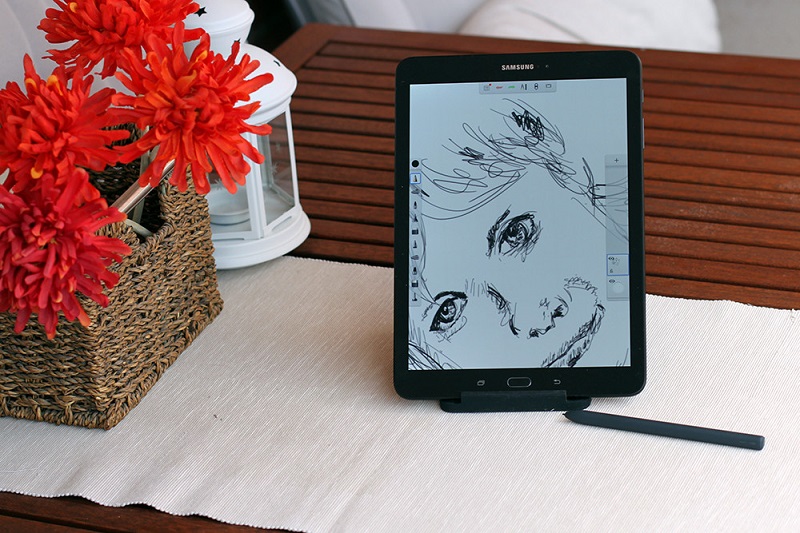
The tablets look for a new dimension. A lifeline that offers them a way out of that clear sales slowdown. Apple did it with the iPad Pro in the wake of the Microsoft Surface Pro, and now it’s Samsung that offers a perfect Android alternative to Apple’s “premium” tablets with these Samsung Galaxy Tab S3.
The reinvention of the Galaxy Tab S3 as devices to produce and not only to consume is remarkable, but after a few days working with it it is still clear that neither the format nor the operating system are even ready to replace a laptop or a Windows convertible in all rule if what you are looking for is to produce.
More than worthy specifications
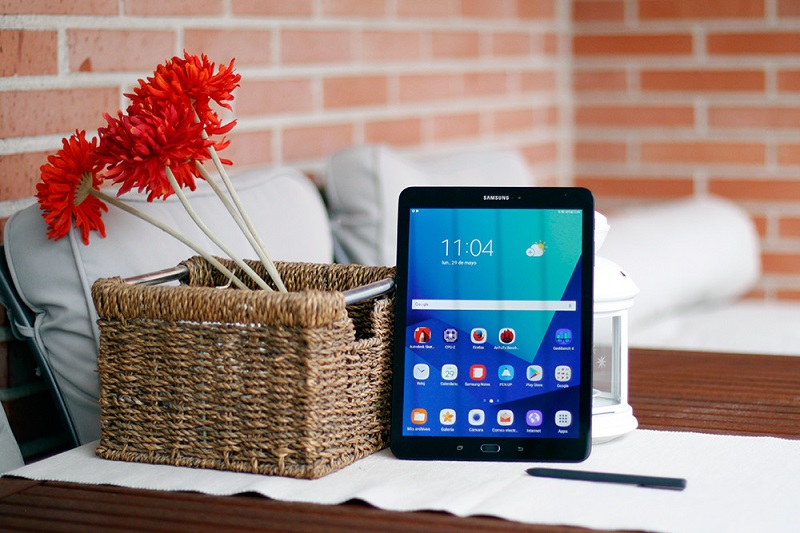
This evolution of Samsung Galaxy Tab S2 that we analyzed last year makes clear how much technology advances in a year. There are significant changes in both the processor and memory or the integrated cameras, which earn integers. Let’s look at those specifications in detail …
| SAMSUNG GALAXY TAB S3 (9.7″) | |
|---|---|
| SCREEN | Super AMOLED 9.7 inches |
| RESOLUTION | 2048 x 1536 pixels, 264 dpi |
| PROCESSOR | Qualcomm Snapdragon 820 |
| GRAPHIC PROCESSOR | Adreno 530 |
| RAM | 4GB RAM |
| MEMORY | 32 GB. Allows microSD up to 256 GB |
| OS VERSION | Android 5.0.2 |
| CONNECTIVITY | GPS + GLONASS, WiFi (802.11 a / b / g / n / ac), BT4.2, LTE, MHL 3.0, USB-C |
| WOMENS SHOES | Rear: 13 MP f / 1.9. Front: 5 MP f / 2.2 |
| DIMENSIONS | 237.3 x 169 x 6 mm |
| WEIGHT | 429 g (WiFi version) |
| BATTERY | 6000 mAh |
| OFFICIAL DEPARTURE PRICE | 679 dollars for 9.7-inch version. |
It should be noted that this model includes the S Pen, the stylus that allows you to take full advantage of writing and drawing functions that are already famous in these tablets and also – of course – in smartphones of the Galaxy Note family.
That is a very attractive point for those who guide the purchase in scenarios where taking notes is key, in addition to saving you do not have to spend the 109 dollars that costs for example the Apple Pencil in the iPad Pro.
In these specifications we can see how the battery grows slightly to 6000 mAh from the 5870 mAh of the previous model, and it does so with very contained dimensions. The charger features Samsung’s Adaptive Fast Charging technology, allowing you to complete the charge at affordable times.
Also note that differential component of Samsung devices: its Super AMOLED screen that on this occasion, for its little outside, offers HDR10 support. We talked later about the impact of this technology on this tablet.
Design: Goodbye to plastic, hello to crystal

There are no flashy changes in the format of a tablet that also follows the line of the iPad Pro in its dimensions: it is a device that has a screen of 9.7 inches and has dimensions and weight virtually identical to those of the iPad Pro, although Samsung are bent on assuming that it is something thinner than Apple.
The debate is the same as always: we would not have minded (as always) that it was something thicker and included a battery of greater capacity, and we wondered how far Samsung could have arrived in battery if instead of 6 mm of thickness had arrived at 7. The weight would also have increased, of course, but the benefits in autonomy would probably be noticeable.
Still what stands out from the design is not that, but a back that leaves the plastic of Tab S2 and points to the glass. The effect is of course visually striking.
More elegant, more “premium” undoubtedly, but not for that better, especially when the glass is not only the perfect catch, but also reconfirms that feeling of fragility to a product that is considerably larger than a smartphone with these materials. A case is almost indispensable here if we want to avoid scares, and that makes it precisely that the reason for being of the glass – at least at the level of design – is lost.
In that design they highlight (as in the iPad Pro) those four speakers that flank the device at its edges and that, yes, we will have to be careful not to cover with the hands to pick it up to give that sound quality that Samsung looks for. As connectors we have a USB-C (new in this family) and the headphone connector, while on one of the “long” sides we have both the power button and the volume buttons.
On the front, as expected, returns the home button that is combined with the fingerprint sensor. That button is flanked by the traditional capacitive buttons of Android, and it is quite possible that the experience of using the tablets make the trend of screens without frames never reach these devices, even though Samsung has already demonstrated what is Capable in this regard with the amazing Galaxy S8 / S8 +.
As in previous reviews, on the other long side we found the connector for the Samsung proprietary keyboard, which is optional and we have not been able to test. This peripheral is precisely key to be able to take advantage of the product in all its extension, although we have been able to take advantage of a keyboard Bluetooth to be able to approach to that experience of “total productivity” that wants to offer Samsung although the price to pay for it is greater than the one of The tablet as such. Without keyboard, important to point out, this product loses almost half of its true purpose.
The Gaaxy Tab S3 screen prepared for that future HDR
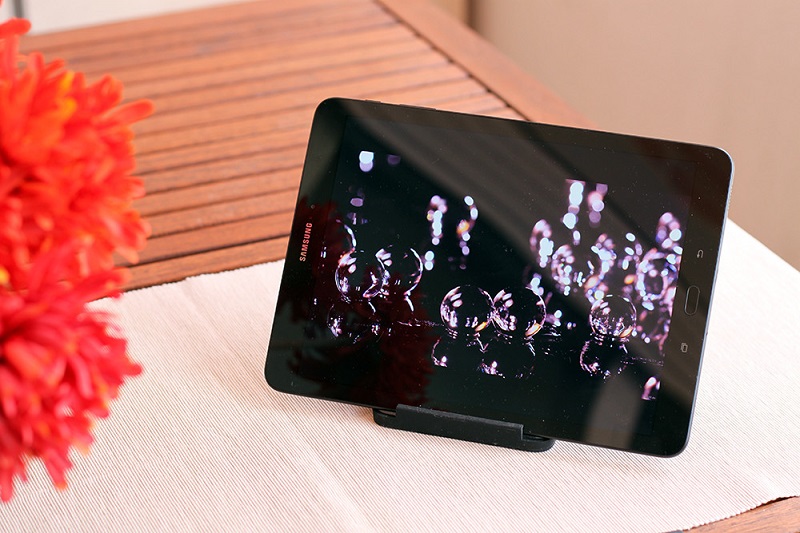
As with most products of the South Korean firm, the screen is one of the remarkable features of a tablet that comes back to surprise by the vividness of the image. The trick of saturating colors continues to work for Samsung, who “cheats” us a little with those shades so vivid and joyful that, indeed, we like to enjoy, especially in video content and games.
The difference in this case is in the support of the standard HDR10, something that at the moment we will not be able to take full advantage of. Services like Netflix or Amazon Prime Video begin to support these contents, but the mobile applications are not yet ready for it.
We tried some YouTube demo videos with that option and the truth is that the image quality is amazing. The brightness, contrast and colors were already fantastic on other Samsung Super AMOLED screens, but this option gives them even more spectacularity, especially if the producers of those videos know how to take advantage of it. The industry seems directed to take advantage of this type of technology, so Samsung here has succeeded in preparing its tablet for the future.
In that multimedia experience is also relevant the role of the speakers, which as we said we will have to be careful not to cover with our hands. The sound they offer us is equally remarkable, with hardly any distortion even at high volumes, something that makes it clear that if you want to enjoy series, movies or even music on this tablet you will be able to do it in an outstanding way.
You may also like to read: Windows 10 on a Snapdragon 835? KS-PRO wants to make it possible
Beyond Performance: Sensations with the Galaxy Tab S3
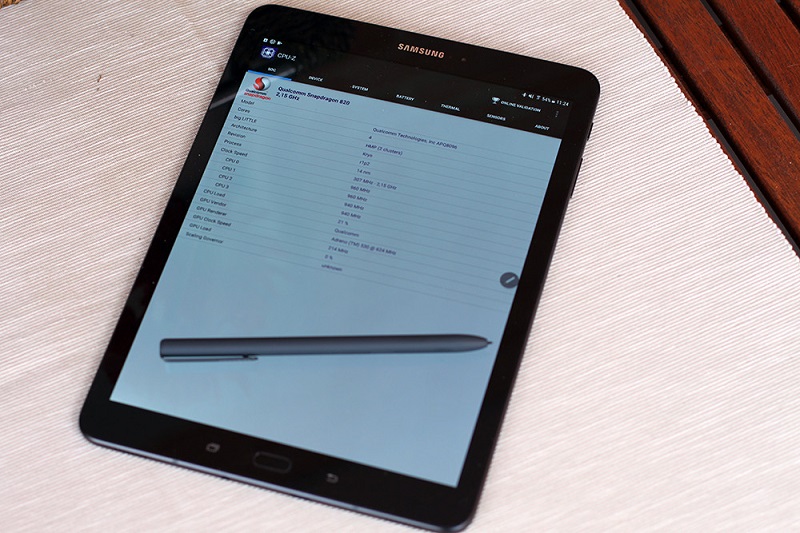
The Snapdragon 820 and the GPU Adreno 530 that are the protagonists of this new iteration are not what they were in 2016, and that shows in performance tests in which obviously the numbers are somewhat worse than those of their most modern competitors.
Even so it is clear that this SoC will continue to give users lots of happiness, and the important thing, despite the figures, is that you stay with the conclusions in the real use: this Tab S3 has an outstanding fluidity in all kinds of scenarios.
In AnTuTu we have reached 142563 points, a remarkable figure, while in GeekBench 4 we achieved 1465 points in single-core and 4090 in multi-core. The rigorous graphical test, 3DMark Ice Storm Unlimited, showed a figure of 20965 points, while Vellamo 2.0 reached 4502 points.
It is clear that the contribution of the processor and those 4 GB of memory contribute to these good figures, but we insist, there are competitors too serious here (the Snapdragon 835, the current Apple A10 and the future Apple A11 make things difficult to Tab S3 Or put them on) that make us not have to contemplate that numerical performance with too much ambition in the field of pure performance.
The battery also has a remarkable behavior, with something more than 7 hours and a half in that normal use in which again we combine the consumption of contents (if you only watch video, the autonomy goes even further and goes beyond 10 hours) with the Web browsing or taking photos and videos. The charge of the battery from zero to 100%, that yes, takes almost three hours even with the technology of the Adaptive Fast Charger.
In the section of the performance of the camera, by the way, the news improves with respect to the previous model thanks to the two sensors clearly superior to those of the Tab S2. The 13 Mps f / 1.9 of the rear camera and the 5 MP f / 2.2 of the front help much to be able to take very decent photos especially if the light is the suitable one. If we are in conditions of low luminosity, yes, the results are less conspicuous.
Here, too, the S7 and S8 inheritance helps: Tab S3 has the same camera application that makes control of the options and the two cameras quick, powerful and efficient. It is remarkable once again to check the 4K support for video recording.
The irresistible S Pen again highlights
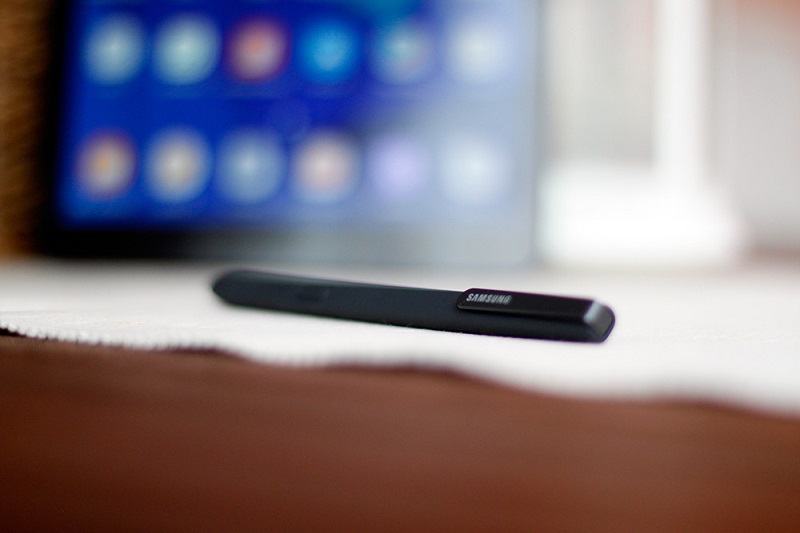
If there is a differential element in the tablets of this family is the S Pen, which charges even more value in these diagonals and also does with features striking against some competitors.
Especially against the Apple Apple Pencil, which as we said costs 109 dollars and also needs to be recharged periodically. The S Pen of the Galaxy Tab S3 comes with the tablet and we do not need to recharge it.
The design has been stylized: its diameter is 9.4 mm although it is not completely circular. There are two slightly flattened sides that contribute to better ergonomics. The 0.7 mm thick tip and rubber material (instead of the plastic of previous models) also makes the sensations when writing or drawing are more “realistic”.
Although there is a clip in this design, there are no magnetic coupling systems as in some competitors, and only if we buy the case with keyboard we can find an element of that case in which precisely the S Pen with its clip. A pity not to have given a native solution to this, something that of course causes us to be careful not to lose it
Samsung’s experience in these scenarios is once again a degree. Not only can we draw or take notes in specific applications: the S Pen button is used to activate Air Command, shortcuts to annotation functions that allow you to capture screen regions for sharing and editing, writing directly to the screen and, in short, converting This pencil in an accessory that can be used in all kinds of situations.
The quality of the S Pen is evident when one starts to draw. We tested with Autodesk SketchBook, since the included utility, Pen.UP, does not let you do anything if you do not associate it with an account in social networks. In SketchBook we could see how the recognition of pressure levels is fantastic, as well as the speed of stroke recognition : there is always a slight delay, but this is very short on this tablet and the S Pen.
That makes the experience of drawing and taking notes excellent with a product that like other competitors seems to be very directed to digital artists who can take advantage of it. For pure productivity we estimate that a keyboard can be much more relevant, but the inclusion of the pencil is certainly interesting.
Software and a format that condition productivity

With a tablet that like the Galaxy Tab S3 has a high cost the question is whether we will really be able to take advantage of it for productivity environments. That’s where Android 7.0 and this device format try to pass our exam. You get it? The short answer is simply no.
They do not do it by two important barriers. The first, the very conception of Android, still very focused on mobile environments and applications maximized. Task management exists, split screen support too, but neither the user experience nor the operative with this environment is as natural or fast as with a desktop environment.
It is true that we can do much of what we do in a conventional laptop, but even accustomed to this way of working – because you have to get used to it – our feeling is that it will be difficult for the flow to be more efficient than in a laptop to use.
To that feeling contributes the fact that this screen with ratio 3:2 also does not help to work with divided screen. Here tablet makers should review their arguments to defend a format that seems much more appropriate to have a single application maximized on the screen. It is curious that this type of design is the usual in tablets, when on mobile phones we begin to see how the “ultra-large” screens of the LG G6 or Galaxy S8 / S8 + show that they want to go further in that direction.
In the area of software we find the traditional Touchwiz layer of mobile devices. In Android 7.0 Nougat that layer does not bother too much, and in fact the fluidity and experience offered by Samsung is remarkable. As usual we found some bloatware – we are not convinced by the default presence of the Flipboard Briefing as we move from the main desk to the left – but in this section there is nothing particularly serious.
